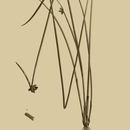en
names in breadcrumbs


Schoenoplectiella mucronata is a species of flowering plant in the sedge family[1] known by the common names bog bulrush,[2] rough-seed bulrush,[3] and ricefield bulrush.[4] It is native to Eurasia, Africa and Australia.[5] It grows in moist and wet terrestrial habitat, and in shallow water. It is a perennial herb growing from a short, hard rhizome. The erect, three-angled stems grow in dense clumps and can reach a metre tall. The leaves take the form of sheaths wrapped around the base of stem, but they generally do not have blades. The inflorescence is a headlike cluster of cone-shaped spikelets accompanied by an angled, stiff bract which may look like a continuation of the stem.[6]: 228–30
It is a weed of rice fields in California.[4][7]
The accepted name for this species is Schoenoplectiella mucronata according to the Council of Heads of Australasian Herbaria,[1] and the Plants of the World Online database.[8]
This plant has some 35 synonyms according to Plants of the world online,[5] but the Council of Heads of Australasian Herbaria lists two.[1] It was first described as Scirpus mucronatus in 1753 by Carl Linnaeus.[1][9] In 1889 Eduard Palla transferred it to the genus, Schoenoplectus,[10] and Schoenoplectus mucronatus was the accepted name until 2010 when it was transferred to the genus, Schoenoplectiella by Jongduk Jung and Hong-Kuen Choi.[1][6]
{{cite journal}}: Cite journal requires |journal= (help) Schoenoplectiella mucronata is a species of flowering plant in the sedge family known by the common names bog bulrush, rough-seed bulrush, and ricefield bulrush. It is native to Eurasia, Africa and Australia. It grows in moist and wet terrestrial habitat, and in shallow water. It is a perennial herb growing from a short, hard rhizome. The erect, three-angled stems grow in dense clumps and can reach a metre tall. The leaves take the form of sheaths wrapped around the base of stem, but they generally do not have blades. The inflorescence is a headlike cluster of cone-shaped spikelets accompanied by an angled, stiff bract which may look like a continuation of the stem.: 228–30
It is a weed of rice fields in California.